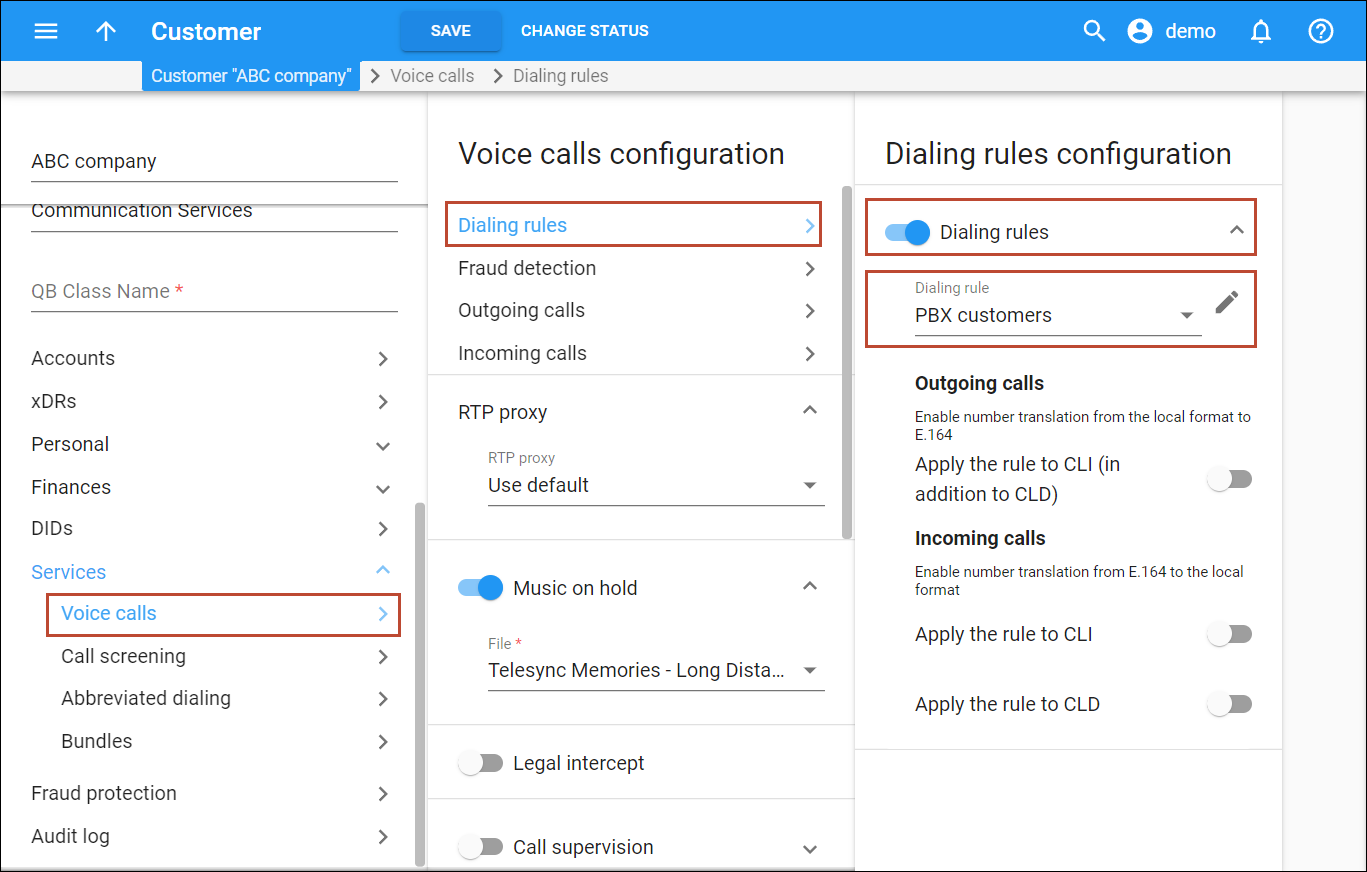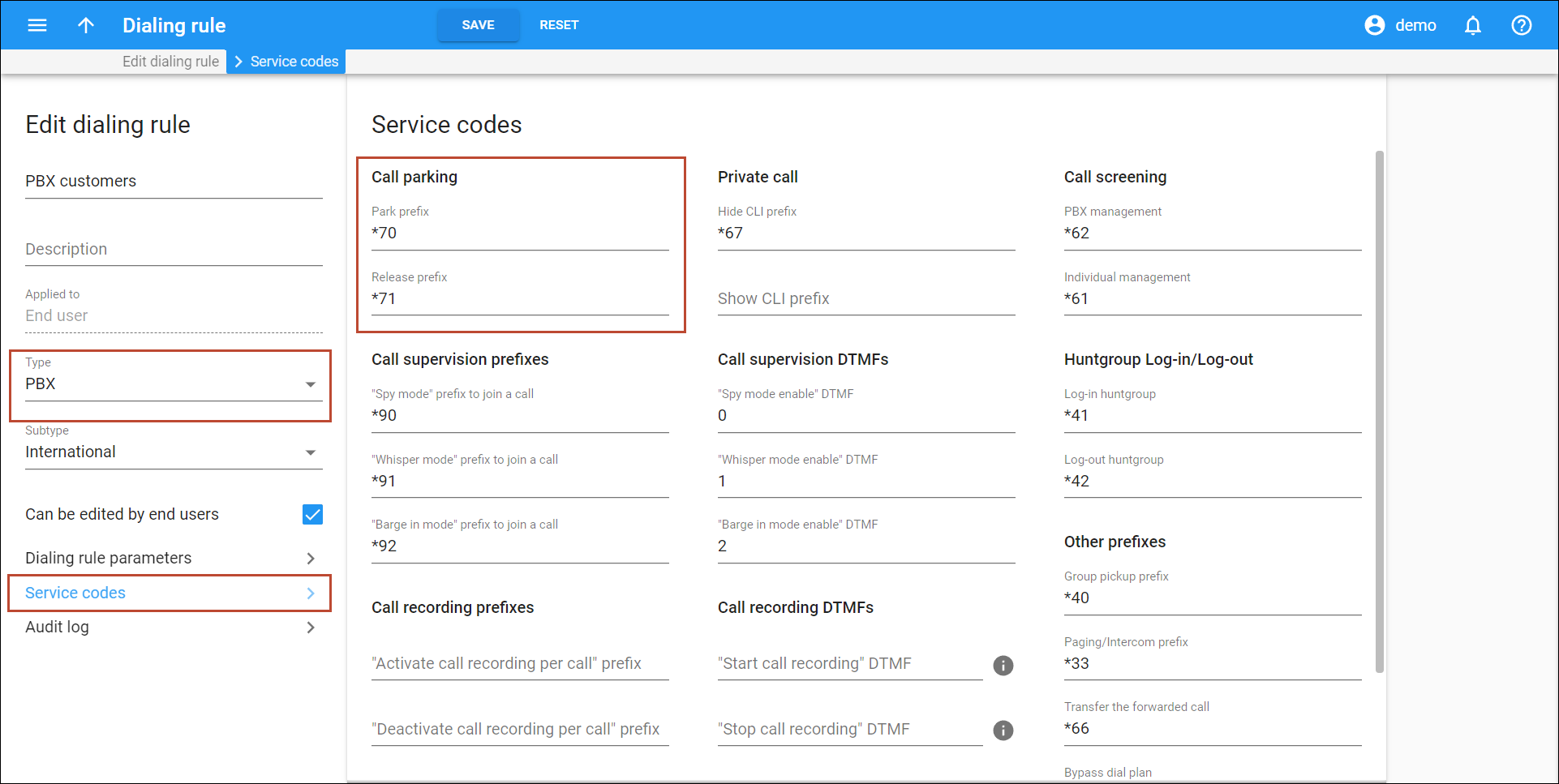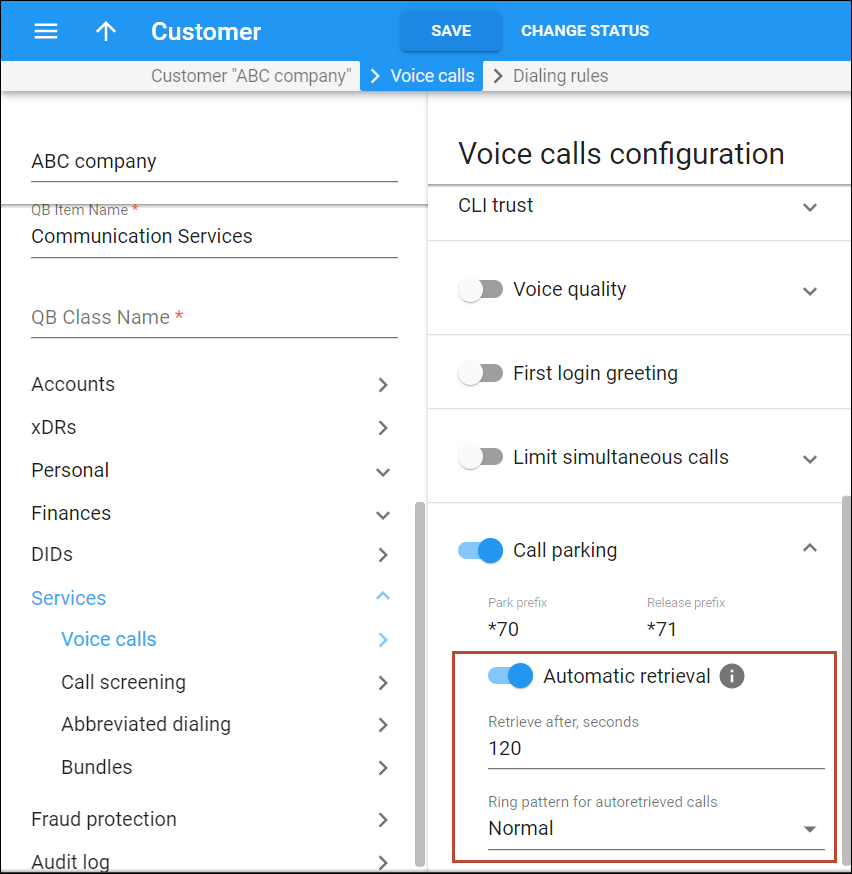Call parking allows users to put a conversation on hold and then resume it from a different IP phone. The section below provides a description of call parking and retrieval using either a randomly generated number or an account’s extension.
Parking a call using a randomly generated number
- A dials B’s phone number (1).
- An authorization request is sent to PortaBilling (2); if authorized successfully (3), the call is connected to B (4).
- B parks the call: puts A on hold and then dials a special call parking prefix (e.g., 644) (5).
- A hears the music-on-hold melody (6).
- The dialed prefix is sent to billing for verification (7).
- Upon successful approval (8), the call parking confirmation message is played to B (9). This message contains a combination number for retrieving the parked call (e.g., 645*7250, where 645 is a release prefix and 7250 is a randomly generated number. The randomly generated number always follows the star to distinguish it from the extension. See the Parking and retrieving a call using an extension section for more details).
Retrieving a parked call using a randomly generated number
- A is still connected via call parking (0).
- B dials the combined retrieving number (e.g., 645*7250) from any IP phone (1).
- An authorization request is sent to PortaBilling (2), which determines that this is an attempt to retrieve the parked call (3).
- The two call legs (A and B) are joined together (4).
Users can park both external calls and calls within PBX by using a parking prefix and any PBX extension.
Consider the following example:
A sales manager, John Doe (extension 333), receives a call from a client. They talk for a while, but it’s too noisy in John’s workspace. John decides to continue the conversation in a conference room. John asks the client to wait a minute until he moves to the conference room. To park the call, John puts it on hold. Then he dials 644333 (where 644 is the call parking prefix followed by John’s extension, 333). John hears the call parking confirmation message. This message contains the combined number to retrieve the parked call – 645333 (where 645 is the release prefix and 333 is John’s extension).
When John comes to the conference room, he dials 645333 to retrieve the call and continues the conversation.
In the example above, John could also use any extension from the same PBX, even if that extension is not participating in the call, e.g., 999. No matter which extension John uses to park the call, he just needs to use the same extension to retrieve the call. Thus, if John parks the call by dialing 644999, he can retrieve the call by dialing 645999.
Parking a call by executing a call transfer
PortaSwitch enables users to park calls by making a transfer to a combination of a park prefix and an extension number. In this case, when John needs to park a call with Mary (ext. 222), he presses the transfer key on his phone and dials *70222, where *70 is the park prefix and 222 is the extension number.
To retrieve the number, John dials *71222, where *71 is the retrieval prefix and 222 is the extension number.
This call parking scenario is supported for both blind and attended transfers.
A user can also park a call by pressing the transfer key on the phone and dialing the park prefix only (e.g., *70). In this case, A (the caller) is placed on hold while B (the user) hears the combination for retrieving the call. It consists of the retrieval prefix and a randomly generated number separated by a star (e.g., *71*1234). B dials this combination from any phone and continues the conversation with A.
This call parking scenario is supported only for an attended transfer since PortaSIP must answer the call to play the call retrieval combination for B.
Call parking with automatic retrieval
Call parking allows PBX users to put a conversation on hold so that it can be resumed from a different IP phone. With this release, a parked call can automatically return to the user who parked it if the call is not retrieved within the specified time (by default, 2 minutes). This allows PBX customers to provide a better service to their clients; if a parked call is forgotten, the client is not disconnected and can resume the conversation.
Let’s consider an example. A patient calls the hospital to talk to Dr. Smith. Mary, the receptionist, puts the patient on hold while she tries to reach Dr. Smith. Mary knows Dr. Smith is not in his office, so there is no point transferring the call to his extension. She decides to park the call and make a public announcement, so Dr. Smith will be able to answer a call on any phone.To park the call, Mary dials *70202 (where “*70” is the call parking prefix and 202 is Dr. Smith’s extension). Afterward, Mary announces through the public address system “Dr. Smith, there is a parked call for you on your extension.” Dr. Smith is busy performing surgery, so he can’t answer the call. After two minutes, the parked call returns to the receptionist’s phone and rings in a different ringtone (that ringtone is configured on the IP phone), so that Mary understands it is a returned call. Mary picks up the call, apologizes to the patient, and asks to leave a message for Dr. Smith.
PBX customers can provide a better service by avoiding “forgotten” parked calls. As the clients stay connected, they don’t need to call again in case there is no answer.
Configuration
To configure call parking with automatic retrieval, the administrator performs the following steps:
- Checks whether the customer has a dialing rule of a “PBX” type assigned:
- opens the Customer record > Services > Voice calls > Dialing rules;
- turns on the Dialing rules toggle switch if disabled;
clicks Edit
next to the selected Dialing rule.

- in the window that opens, checks the Type of dialing rule (it has to be “PBX”) and the Call parking prefixes on the Service codes panel. The administrator can change the prefixes here if needed, but it will also change for all the customers who use this dialing rule.

- Enables the Call parking feature:
- Configures the Automatic retrieval option:
- The automatic retrieval option won’t work if the customer uses the Override identity feature and has configured another Identity to display. In this case, the call won’t return to the user who parked it.
- When a parked call returns to the user who parked it, and the user is not answering or is on another call, the returned call is processed according to the selected Answering mode.



_solution/Park%20the%20call.png)
_solution/Call%20retrieval.png)

